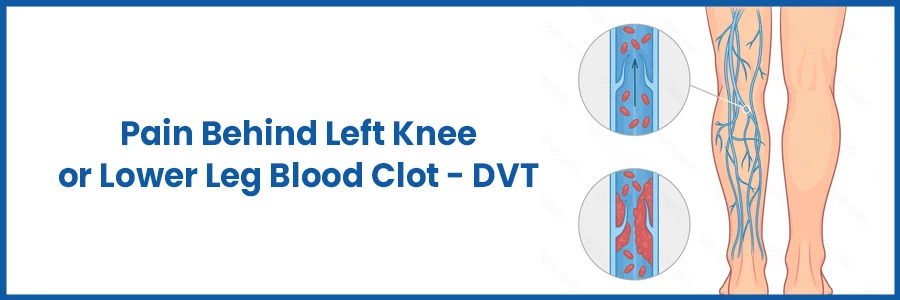- Cardiology 84
- Dermatology 45
- Endocrinology 33
- ENT 16
- Fertility 190
- Gastroenterology 78
- General-Medicine 81
- Gynecology 80
- Hematology 19
- Infectious-Diseases 33
- Neurology 52
- Oncology 34
- Ophthalmology 23
- Orthopedics 69
- Pediatrics 31
- Procedure 23
- Public-Health 144
- Pulmonology 59
- Radiology 8
- Urology 68
- Wellness 161
- Woman-and-child 77

What is DVT?
Deep Vein Thrombosis (DVT) is a serious condition characterised by the formation of blood clots in deep veins, typically in the legs. One common symptom of DVT is pain behind the knee or in the lower leg.
Deep Vein Thrombosis occurs when a blood clot forms in one or more of the deep veins in the body, usually in the legs. These clots can partially or completely block blood flow, leading to various complications.
Pain Behind Left Knee Blood Clot
Pain in the decreased back of the left knee may additionally have several motives, beginning from muscle strains to vascular issues. One of the massive issues related to this ache is the possibility of a blood clot, also called deep vein thrombosis (DVT).
DVT will upward thrust up at the same time as a blood clot administrative centre artwork in a deep vein, frequently inside the legs. This clot has the functionality to break unfastened, go through the bloodstream, and become lodged within the lungs, posing excessive fitness risks.
Causes of DVT:
- Prolonged immobility, such as during long flights or bed rest.
- Injury to a vein, often due to surgery or trauma.
- Certain medical conditions or treatments that affect blood clotting.
- Family history of blood clots.
- Pregnancy or recent childbirth.
- Smoking and obesity are also risk factors.
Secure your health with a second opinion. Make informed decisions and book your appointment today!
Get A Second OpinionWhat are the causes of a blood clot in the knee?
A blood clot in the knee, also known as deep vein thrombosis (DVT), can be caused by factors such as prolonged immobility, surgery, injury to the knee or leg, genetic predisposition to clotting disorders, pregnancy, hormone therapy, or certain medical conditions like cancer and heart disease.
Symptoms of DVT Behind the Knee:
- Behind the left knee or in the lower leg, there is pain or tenderness, often felt as a dull ache.
- Swelling, warmth, or redness in the affected area.
- Skin discolouration.
- Visible veins.
- Some people may not experience any symptoms, making DVT a silent threat.
Risk Factors of DVT:
Certain factors increase the risk of developing DVT, including:
- Age over 60
- Obesity
- Smoking
- History of DVT or pulmonary embolism
- Use of hormone replacement therapy or oral contraceptives
- Pregnancy or recent childbirth
- Cancer treatment
How to Diagnosis and Treat a Blood Clot Behind the Knee?
If you suspect you have DVT, it's crucial to seek medical attention promptly. A healthcare provider may perform a physical examination, ultrasound, or other imaging tests to diagnose DVT accurately.
Treatment for DVT aims to prevent the clot from growing larger, reduce the risk of complications like pulmonary embolism, and prevent the formation of new clots. Standard treatment options include:
\- Anticoagulant medications (blood thinners).
- Thrombolytic therapy (clot-dissolving medications).
- Compression stockings.
- In some cases, surgery may be necessary to remove the clot.
Ready to take control of your health journey? Book your appointment now and start your path towards wellness today!
Book an AppointmentHow can blood clots be prevented?
- Stay active and avoid prolonged periods of sitting or lying down.
- Maintain a healthy weight and adopt a balanced diet.
- Quit smoking and limit alcohol consumption.
- Stay hydrated by drinking plenty of water.
- Wear compression stockings if recommended by your doctor.
- Manage chronic conditions like diabetes and high blood pressure.
- Follow your doctor's advice regarding medications, especially if you are at risk for clotting disorders.
Conclusion:
Pain behind the left knee or in the lower leg can be a warning sign of Deep Vein Thrombosis, a potentially life-threatening condition.
Understanding the causes, symptoms, and treatment options for DVT is crucial for early detection and prevention of complications.
If you experience persistent pain or swelling in your legs, seek medical attention promptly to rule out DVT and receive appropriate treatment.
Frequently Asked Questions
Yes, it could be a symptom of Deep Vein Thrombosis (DVT), a serious condition requiring medical attention.
No, DVT typically requires medical treatment to prevent complications.
It's important to follow your doctor's advice. Gentle exercise like walking can sometimes be recommended, but high-intensity activities may need to be avoided.
Treatment duration varies based on the severity of the clot and individual health factors. It can range from several months to longer-term.
Consuming a nutritious diet rich in fruits, vegetables, & whole grains can improve overall cardiovascular health and lower the chance of developing DVT.
Long flights or sitting for extended periods during travel can increase the risk of DVT. It's advised to move around and stay hydrated during flights.
Signs include increasing leg pain, swelling, redness, or difficulty breathing. If you have these symptoms, seek medical attention right once.

- Cardiology 2132
- Dermatology 168
- Endocrinology 135
- ENT 97
- Fertility 217
- Gastroenterology 232
- General 478
- General-Medicine 1685
- Gynecology 169
- Hematology 85
- Infectious-Diseases 208
- Neurology 207
- Oncology 345
- Ophthalmology 65
- Orthopedics 187
- Pediatrics 83
- Procedure 72
- Public-Health 209
- Pulmonology 126
- Radiology 13
- Second Opinion 311
- Urology 294
- Wellness 600
- Woman-and-child 447
- Others 10217
Related Blogs
If you have any questions, please fill out the enquiry form or call us, and we will get back to you promptly.
040-68334455